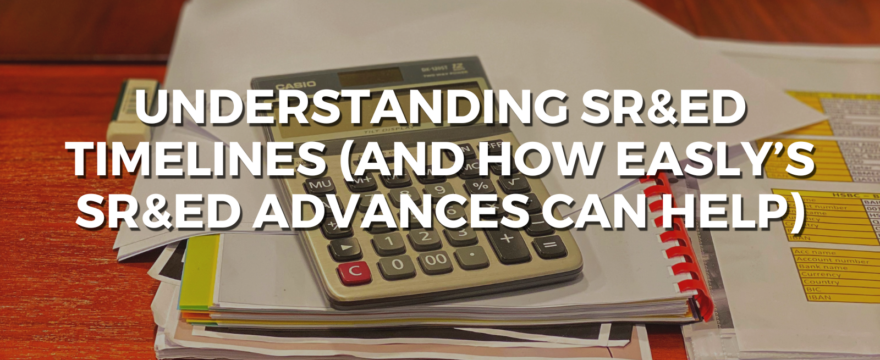
Canadian companies pushing the boundaries of innovation often need financial support to fuel their projects. Businesses need to pay close attention to their cash runway and burn rate, as many startups fail due to a lack of available capital. When a business is struggling to meet monthly expenses, it’s difficult to act on the big ideas that would help it grow. However, these ‘big ideas’ have the potential to become the technological breakthroughs that shape our world.
The Scientific Research and Experimental Development (SR&ED) program is a solution to these challenges. The program provides tax incentives for eligible businesses pursuing innovative ideas. SR&ED tax credits are vital to Canada’s research and development (R&D) ecosystem. Not only do they provide substantial financial support for businesses pursuing scientific and technological advancements, but they also make it possible to fund experimental ideas that aren’t certain to pan out but have the potential to expand our scientific and technological understanding.
SR&ED tax credits help founders, startups, and other innovators pursue valuable research without having to worry about immediate ROI. It also helps these businesses succeed over the long term. However, ‘long term’ thinking can be a challenge when cash flow needs arise over the short term.
SR&ED 101
Maximizing the SR&ED program’s benefits requires proactive planning and expert guidance. In order to file an SR&ED claim, you’ll need to prepare documentation to describe what you’re attempting to discover and how you’ve gone about testing your hypothesis. Eligible SR&ED projects are:
- Built around gaining knowledge, like creating new products or improving processes
- Designed to solve a hypothesis, invent a tool, or discover something new
- Supported by evidence and executed in a logical, systemic way
Once you have an eligible project, you’ll need to provide the documentation to prove it. Then, you’ll need to file the claim with the CRA.
As of 2024, the CRA service standard for processing SR&ED claims is 60-180 days, depending on if your claim is subject to an audit. You’ll also need to prepare your claim for submission, either with the help of an SR&ED consultant or by preparing documentation yourself. Filing an SR&ED claim is only done once per year.
Before starting any research and development activities, taking a proactive approach and planning ahead for your SR&ED claim is crucial. Developing a comprehensive SR&ED strategy with the guidance of an SR&ED consultant can be a smart decision. As described above, the process can have many moving parts. These professionals are well-versed in the intricacies of the SR&ED program and its requirements; they can ensure your efforts are optimized and your deadlines are met. If you need assistance finding an SR&ED consultant, Easly can direct you to several of our trusted partners.
Documenting Progress
When it comes to SR&ED, thorough documentation is paramount. The success of your SR&ED claim hinges not only on your project meeting the eligibility criteria but also on the quality and completeness of your documentation. To keep this process simple, creating and maintaining detailed records from the outset of your R&D endeavours is best. Documenting work as it happens and dating the records is a straightforward way to provide evidence of the progression of your project.
This documentation should not only serve as a record of your activities but also as a foundation for your claims in the technical reports required. The more meticulous and consistent the documentation, the stronger your claim will be. Additionally, sound documentation practices can significantly expedite the process over the course of your project and claim and make validating your activities and expenses easier when filing for SR&ED.
Key Factors Often Overlooked
When preparing an SR&ED claim, there are several common things that claimants tend to overlook. Understanding and addressing these oft-overlooked factors can make a substantial difference in the success of your SR&ED claim and help reduce the possibility of a time-consuming audit:
- Document Organization: Keeping your project documents organized and accessible is crucial. Ensure that your documentation is well-structured, with clear sections for different phases of your R&D activities. This not only helps you stay on top of your project but also simplifies the preparation of your SR&ED claim.
- Showing Proof of Relevance: It’s essential to provide compelling proof of how your work relates to the SR&ED project. Demonstrate the scientific or technological advancements you’re pursuing and how your activities contribute to achieving those goals. A well-structured argument can strengthen your claim.
- Working with Contractors: Collaborating with contractors, whether local or international, is a common practice in R&D. While you can claim contractor fees as part of your SR&ED claim, it’s important to note that only 80% of the total eligible work hours can be claimed, compared to 100% for salaried employees. Understanding the rules regarding contractor expenses is crucial to maximizing your SR&ED tax credits.
Easly: Your Partner in SR&ED Advances
One of the advantages of working with Easly is the cash flow boost you receive through our SR&ED advances. Waiting for your annual SR&ED refund can lead to significant cash flow challenges, hindering your R&D efforts. But with Easly, you don’t have to wait! We offer the option to finance your SR&ED credits throughout the year based on accrual, providing you with the funds you need to maintain momentum.
Easly’s cash flow calculator can help you estimate the SR&ED advances you may be eligible to receive. Contact our team today to learn more about our Capital-as-a-Service (CaaS) platform and how we can support your R&D initiatives through our SR&ED advances.
.png)
.png)
.png)
